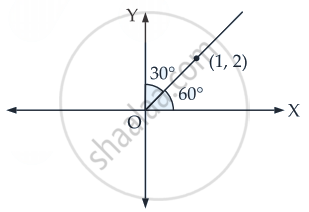Advertisements
Advertisements
प्रश्न
Find the equation of lines passing through (1, 2) and making angle 30° with y-axis.
उत्तर
Given that the line makes angle 30° with y-axis
∴ Angle made by the line with x-axis is 60°
∴ Slope of the line
m = tan 60°
⇒ m = `sqrt(3)`

So, the equation of the line passing through the point (1, 2)
And slope `sqrt(3)` is y – y1 = m(x – x1)
⇒ y – 2 = `sqrt(3)(x - 1)`
⇒ y – 2 = `sqrt(3)(x - 1)`
⇒ `y - sqrt(3)x + sqrt(3) - 2` = 0
Hence, the required equation of line is `y - sqrt(3)x + sqrt(3) - 2` = 0
APPEARS IN
संबंधित प्रश्न
Find the equation of the line perpendicular to x-axis and having intercept − 2 on x-axis.
Draw the lines x = − 3, x = 2, y = − 2, y = 3 and write the coordinates of the vertices of the square so formed.
Find the equations of the straight lines which pass through (4, 3) and are respectively parallel and perpendicular to the x-axis.
Find the equation of a line equidistant from the lines y = 10 and y = − 2.
Find the equation of the line passing through (0, 0) with slope m.
Find the equation of the line passing through \[(2, 2\sqrt{3})\] and inclined with x-axis at an angle of 75°.
Find the equations to the altitudes of the triangle whose angular points are A (2, −2), B (1, 1) and C (−1, 0).
Find the equation of the line passing through the point (−3, 5) and perpendicular to the line joining (2, 5) and (−3, 6).
Find the equation of the straight lines passing through the following pair of point :
(0, −a) and (b, 0)
Find the equations of the sides of the triangles the coordinates of whose angular point is respectively (0, 1), (2, 0) and (−1, −2).
Find the equations to the diagonals of the rectangle the equations of whose sides are x = a, x = a', y= b and y = b'.
The vertices of a quadrilateral are A (−2, 6), B (1, 2), C (10, 4) and D (7, 8). Find the equation of its diagonals.
Find the equation of the straight line which passes through (1, −2) and cuts off equal intercepts on the axes.
Find the equation to the straight line which cuts off equal positive intercepts on the axes and their product is 25.
Find the equations of the straight lines each of which passes through the point (3, 2) and cuts off intercepts a and b respectively on X and Y-axes such that a − b = 2.
Find the equation of the straight line passing through the point (2, 1) and bisecting the portion of the straight line 3x − 5y = 15 lying between the axes.
Find the equation of the straight line passing through the point of intersection of the lines 5x − 6y − 1 = 0 and 3x + 2y + 5 = 0 and perpendicular to the line 3x − 5y + 11 = 0 .
Find the equation of a line passing through (3, −2) and perpendicular to the line x − 3y + 5 = 0.
Find the equation of the straight lines passing through the origin and making an angle of 45° with the straight line \[\sqrt{3}x + y = 11\].
Find the equations of the straight lines passing through (2, −1) and making an angle of 45° with the line 6x + 5y − 8 = 0.
The equation of one side of an equilateral triangle is x − y = 0 and one vertex is \[(2 + \sqrt{3}, 5)\]. Prove that a second side is \[y + (2 - \sqrt{3}) x = 6\] and find the equation of the third side.
Find the equations of the two straight lines through (1, 2) forming two sides of a square of which 4x+ 7y = 12 is one diagonal.
Two sides of an isosceles triangle are given by the equations 7x − y + 3 = 0 and x + y − 3 = 0 and its third side passes through the point (1, −10). Determine the equation of the third side.
Write the integral values of m for which the x-coordinate of the point of intersection of the lines y = mx + 1 and 3x + 4y = 9 is an integer.
A line passes through the point (2, 2) and is perpendicular to the line 3x + y = 3. Its y-intercept is
If a + b + c = 0, then the family of lines 3ax + by + 2c = 0 pass through fixed point
The equations of the lines which pass through the point (3, –2) and are inclined at 60° to the line `sqrt(3) x + y` = 1 is ______.
